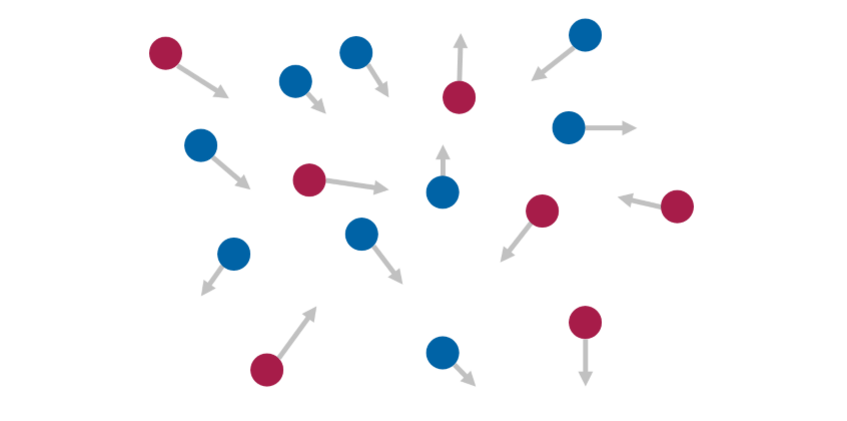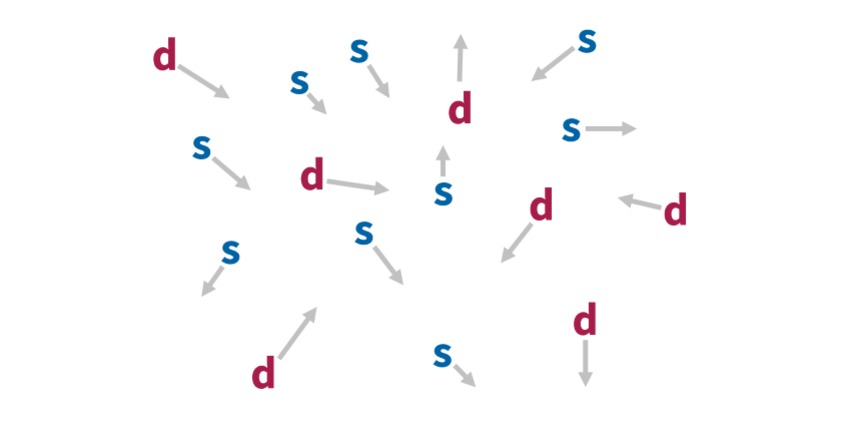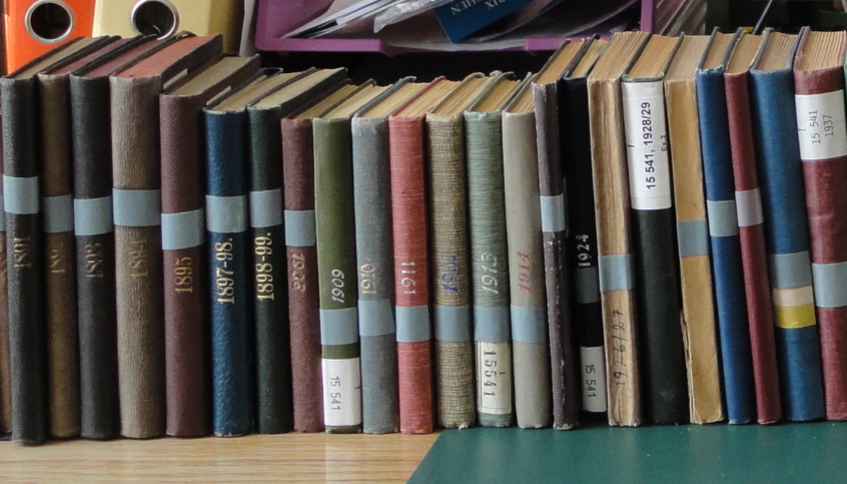Mathematical-physical procedures to describe language spread as diffusion
Mathematical-physical procedures to describe language spread as diffusion
Diffusion in physics and chemistry means the spread of particles over time and space. This spread follows Fick’s diffusion equation (A. Fick 1855) which has—under certain constraints—a Gaussian function (a bell curve) as a solution. In this equation, diffusion is characterized by the “diffusion constant”. When the diffusion constant increases and particles diffuse faster, the Gaussian curve becomes broader.
Investigating the diffusion of languages and of words in languages with similar mathematical methods as the diffusion of particles is a recent development. For a long time, the contrast between the natural sciences and the humanities was seen as a hurdle too big to overcome. Skepticism prevailed that the spread of an immaterial good such as language could be described by exact mathematical methods used to study the spread of material things like particles. It was argued that the application of such methods would be too reductionist.

Physical diffusion: Movement of atoms

Linguistic diffusion: Movement of language(s)
Finally the ice was broken: Using simple rate equations such as those used to model the radioactive decay, D.M. Abrams and S.H. Strogatz described the temporal (“diachronic” as linguists call it) decline of minority languages and replacement by dominant languages with “higher prestige”. Several researchers have recently extended Abrams and Strogatz’s model to spatial spread processes, i.e. to language diffusion. They used a system of extended diffusion equations for describing the progress of one and the retreat of another language as coupled processes. These kinds of model may be termed “macroscopic” since separate population units are not considered in detail. One may criticize that “prestige”—which often plays a central role in macroscopic models—is not defined and the size of the prestige parameter follows simply from fitting the model to data.
The procedure we have developed is more detailed. It is based on the method of cellular automata where the landscape is divided into small grid cells which can be looked at individually. This means that we describe the development by taking into account the linguistic influence of neighboring population cells, i.e. hamlets, villages, towns according to their population size and relative distance. To follow the spread of languages over a large area and time period, extensive computer simulations are needed because the data should comprise a large number of population cells mutually influencing each other. In contrast to the above-mentioned macroscopic models, we call our procedure “microscopic” due to the look at individual population units. To reach that level of exactness, we need very detailed empirical data (this is called “high resolution data” in physics).
We thus describe the interaction between speakers of two languages leading to spread of one and retreat of the other one with a model based on physical diffusion. This model considers the language in the neighboring population units and the mutual interaction with speakers of the same language. The interaction is proportional to the number of speakers of each language and decreases with distance. Applying the same model to all population units in the investigated area, we optimize the simulation by comparing simulation results with the number of speakers of either language as determined by the censuses.
Literature
- Abrams, Daniel M./Strogatz, Steven H. (2003). Modelling the dynamics of language death. Nature 424:900. DOI :10.1038/424900a.
- Isern, Neus/Fort, Joaquim (2014). Language extinction and linguistic fronts. J R Soc Interface 11(94). DOI: 10.1098/rsif.2014.0028.
- Kandler, Anne (2009). Demography and Language Competition. Human Biology 81:181–210. DOI: 10.3378/027.081.0305.
- Mehrer, Helmut (2007). Diffusion in Solids. Fundamentals, Methods, Materials, Diffusion-Controlled Processes. Berlin-Heidelberg: Springer.
- Patriarca, Marco/Heinsalu, Els (2008). Influence of geography on language competition. Physica A 388:174–186. DOI: 10.1016/j.physa.2008.09. (available as PDF)
- Patriarca, Marco/Leppänen, Teemu (2004). Modeling language competition. Physica A 338:296–299. DOI: 10.1016/j.physa.2004.02.056.
- Walters, Caroline E. (2014). A reaction–diffusion model for competing languages. Meccanica 49:2189–2206. DOI: 10.1007/s11012-014-9973-2.
- Schulze, Christian/Stauffer, Dietrich/Wichmann, Søren (2007). Birth, survival and death by Monte Carlo simulation. Commun Comput Phys 3(2):271–294. (preprint as PDF)
- > more literature suggestions
Slovenian-German in Carinthia

Additional sources of information: “Teachers' calendars” tell us where Slovenian was taught in schools historically.
Slovenian-German in Carinthia
The study described here is devoted to the decline of the Slovenian language in Southern Carinthia.
For this region, we have access to a detailed data set of the vernacular languages of people in Southern Carinthia. In the Austro-Hungarian Empire–which Carinthia was part of—censuses with high spatial resolution were undertaken every ten years starting in 1880. After the collapse of the Austro-Hungarian Empire, the detailed censuses were continued in the Republic of Austria until 2001 [ref]. These data form the basis for our study of language diffusion in Carinthia. The result of our study is that it is essentially the interaction with speakers of the same language which leads to the continuous spread of German and therefore the retreat of Slovenian. Bilingual schools and the use of Slovenian in the church appear to have little effect. However, the development in the larger towns Klagenfurt and Villach is different: During the first investigation period (up to World War I) we see a faster decline of Slovenian in large towns than elsewhere. In the second period (1971–2001), the development is the opposite and the number of Slovenian speakers even increases in Klagenfurt.
What did we know about the evolution of the languages in this part of the world until now? For the Austrian-Hungarian Empire and thus the period before World War I, E. Brix has undertaken a comprehensive investigation. Brix discusses the reliability of the censuses for the ten languages of the Empire. He considers possible data errors due to politically motivated officials responsible for the data collection. However, he mainly refers to peripheral regions of the Empire where the proportion of illiterate people was particularly high and not to Carinthia. In the book, the fact that the recorded vernacular language sometimes was rather a personal statement than a linguistic fact is also addressed. In addition, the problems raised by the question “What is a vernacular language?” should not be overlooked.
In the time from the end of World War I to the years after World War II, many conflicts took place in Carinthia — a short historical overview is given e.g. by V. Inzko et al. The data from censuses and hence language surveys in that period are only partly available in the same detail as the ones of the periods used in this study (1880–1910 and 1971–2001). Additionally, we have to assume that the language during these times of political upheaval followed not the laws of diffusion but different patterns. Therefore, these periods are not included in our simulations.
Literature
- Brix, Emil (1982). Die Umgangssprachen in Altösterreich zwischen Agitation und Assimilation. Die Sprachenstatistik in den zisleithanischen Volkszählungen 1880 bis 1910. Wien: Böhlau.
- Inzko, Valentin et al. (1988). Geschichte der Kärntner Slowenen: von 1918 bis zur Gegenwart unter Berücksichtigung der gesamtslowenischen Geschichte. Klagenfurt: Hermagoras.
- Priestly, Tom (2000). „Slovene in Austria“. In: Minderheiten- und Regionalsprachen in Europa. Ed. Jan Wirrer. Wiesbaden: Westdeutscher Verlag.
- Teibenbacher, Peter/Kramer, Diether/Göderle, Wolfgang (2012). An Inventory of Austrian Census Materials, 1857–1910. Final Report. Graz: Mosaic Working Paper WP-2012-007. (available as PDF)
- > more literature suggestions
